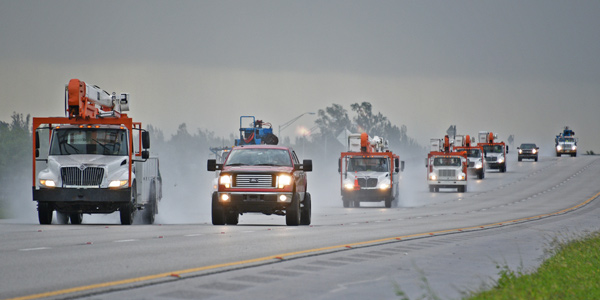About 97% of customers who lost power during Hurricane Irma have had their service restored, utilities and regulators reported Monday.
Parts of Alabama, North Carolina, South Carolina and every county in Florida and Georgia were impacted by Irma, which prompted what Tom Bossert, President Trump’s homeland security and counterterrorism adviser, called the “largest ever mobilization of line restoration workers” in U.S. history.
More than 60,000 utility workers deployed from more than 30 states and Canada. Dozens of utilities — including Atlantic City Electric, AEP Ohio, Avista, Black Hills Energy, Consumers Energy, Consolidated Edison, Dayton Power & Light, Delmarva Power, Dominion Energy, Duquesne Light, Entergy, Eversource Energy, FirstEnergy, Green Mountain Power, Hydro-Quebec, Indiana Michigan Power, Jersey Central Power & Light, Kansas City Power & Light, Liberty Utilities, National Grid, Pepco, Northern Indiana Public Service Co., Pacific Gas and Electric, Texas-New Mexico Power, Toronto Hydro, and Wisconsin Public Service — reported sending crews.
As of Monday, they had eliminated significant outages everywhere except Florida.
The Florida Public Service Commission said almost 312,000 customers, 3% of the state’s total, were still without power as of 6 p.m. Monday. Florida Power & Light had about 160,000 customers still out, down from 4.45 million. Duke Energy had almost 94,000 out, 5% of its total. Georgia Power reported 171 customers still dark as of Monday evening.
At Irma’s peak on Sept. 11, more than 7.8 million customers were without power.
The Edison Electric Institute said work had been slowed by debris, fallen trees and downed power lines. But FPL spokesman Bryan Garner told the Palm Beach Post that the restoration was four times faster than it was following Hurricane Wilma in 2005, thanks to $3 billion in grid-hardening investments since then.
The effort included strengthening 600 transmission lines, placing more than 450 lines underground and clearing vegetation from more than 135,000 miles of wires. More than 1.2 million poles have been inspected and upgraded or replaced. Also speeding the recovery was the installation of millions of smart meters and grid devices that help detect problems. FPL deployed almost 50 drones to assess the damage.
But not all the investments worked out. About 40% of FPL’s system is underground, but uprooted trees damaged some underground lines in Homestead, south of Miami.
“One of the things you are seeing in particular with FPL’s investment in hardening their system is not that it prevented outages, but that it allowed for the restoration process to be a lot quicker and a lot safer,” EEI Executive Director Scott Aaronson told the Post.
Even if customers paid $1,000/kWh, Aaronson said, “I still cannot guarantee that there are not going to be outages. There is no such thing as risk elimination. It is really about risk management.”
— Rich Heidorn Jr.







